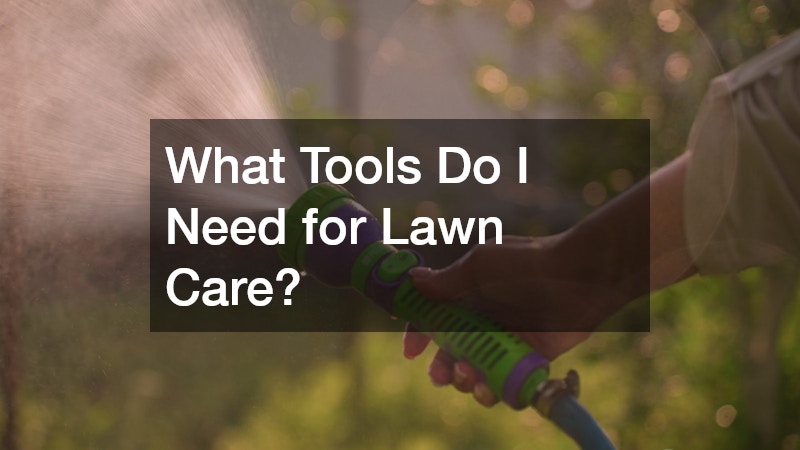Lawn care is more than just mowing once a week—it’s a year-round process that involves attention to soil health, water management, and the right equipment. A well-maintained lawn adds curb appeal, provides a comfortable outdoor space for family activities, and even increases property value. Yet many homeowners find themselves unsure of where to begin or how to manage competing tasks like watering, fertilizing, and weed control without overdoing it.
How Often Should I Mow My Lawn?

Factors Influencing Mowing Frequency
The frequency of mowing depends largely on grass type, local climate, and the time of year. Cool-season grasses grow rapidly in spring and fall, requiring more frequent mowing during those months, while warm-season grasses thrive in summer heat. Soil fertility and irrigation also play a role; well-fertilized and properly watered lawns grow faster, meaning you’ll need to mow more often. A lawn fertilizing company may provide tailored advice based on soil testing, helping you determine how growth patterns will influence your mowing schedule.
Seasonal Mowing Considerations
Different seasons require adjustments to your mowing routine. During spring, rapid growth may demand mowing every 4–5 days, while in summer, you may be able to space it out to once a week or longer depending on rainfall and irrigation. Fall mowing focuses on keeping grass healthy before winter dormancy, while late-season mowing should leave grass slightly taller to protect against cold stress.
What Type of Grass Is Best for My Region?
Cool-Season vs. Warm-Season Grasses
Grass choice is one of the most important decisions in lawn care, as not all varieties thrive under the same conditions. Cool-season grasses, like Kentucky bluegrass and fescue, are well suited for northern climates with colder winters and moderate summers. Warm-season grasses, such as Bermuda and zoysia, thrive in hot southern regions where summer heat is more intense.
The right choice reduces maintenance over time, as grass adapted to your climate will resist disease, handle foot traffic better, and recover more quickly after mowing or stress. A lawn fertilizing company may offer region-specific blends, while some homeowners prefer experimenting with seed mixes that incorporate both cool- and warm-season varieties for transitional climates.
Local Climate and Soil Conditions
Climate and soil conditions should guide your grass selection as much as temperature zones. Sandy soils drain quickly and may require grass types with deep root systems, while clay soils hold water and need grasses tolerant of wet conditions. Soil testing can reveal nutrient levels, and if deficiencies are found, you may supplement with farm fertilizer or organic compost.
Sunlight exposure also plays a role. Lawns shaded by large trees often require shade-tolerant varieties, which means you may need to coordinate with a local tree service for pruning or tree trimming to balance light availability. Combining these practices with efficient sprinkler installation ensures that both shaded and sunny areas receive the hydration they need.
How Do I Properly Water My Lawn?
Best Time of Day to Water
The ideal time to water is early in the morning, typically between 6 a.m. and 10 a.m., when temperatures are cooler and winds are calmer. This reduces evaporation and ensures more water reaches the soil. Evening watering is less effective, as prolonged moisture on grass blades can encourage disease growth.
For homeowners with larger properties, timed sprinkler installation systems are especially useful. Pairing them with weather-based sensors prevents overwatering during rainy periods, saving both water and money. Coordinating watering with seasonal lawn care schedules, such as fertilization or tree trimming, further optimizes overall yard health.
Common Watering Mistakes to Avoid
One of the biggest mistakes homeowners make is watering too frequently. Daily watering encourages shallow root growth and leaves lawns prone to drought. Another mistake is ignoring soil type; sandy soil requires more frequent watering, while clay holds water longer. Using fertilizer spreaders incorrectly—such as applying fertilizer right before heavy rain—can also waste resources and damage grass.
Another overlooked issue is uneven watering. Obstacles like trees, flower beds, or even a concrete retaining wall can block spray patterns, leading to patchy growth. Regularly checking your sprinkler installation for clogs or leaks ensures more consistent coverage, helping you maintain a balanced and attractive lawn.
What Fertilizer Should I Use?

Understanding N-P-K Ratios
Fertilizer labels display three numbers representing nitrogen (N), phosphorus (P), and potassium (K). Nitrogen promotes leafy growth, phosphorus supports root development, and potassium strengthens overall plant health. The right balance depends on your soil’s natural nutrient profile, which can be determined through testing.
A lawn fertilizing company may recommend different blends throughout the year. For instance, higher nitrogen in spring supports rapid green-up, while balanced or potassium-rich fertilizers in fall prepare grass for winter. Farm fertilizer may be more cost-effective for larger properties, while smaller yards benefit from easy-to-apply fertilizer spreaders.
Timing Your Fertilization Schedule
The timing of fertilizer applications has a major impact on results. For cool-season grasses, the best times are early spring and fall, while warm-season grasses benefit from late spring through summer. Avoid fertilizing during extreme heat or drought, as this can stress the lawn.
Fertilizer spreaders make it easier to apply products evenly, while sprinkler installation helps activate the nutrients by carrying them into the soil. Larger properties, particularly those featuring design elements like a concrete retaining wall or tree plantings, may require more careful planning. Partnering with a lawn fertilizing company ensures correct timing, dosage, and coverage, leading to a stronger, greener lawn.
How Do I Control Weeds Effectively?
Identifying Common Lawn Weeds
Effective weed control begins with knowing what you’re dealing with. Common lawn weeds include dandelions, clover, crabgrass, and broadleaf plantain. Some are annuals, while others are perennials that can return year after year if not addressed properly. Identifying weeds early allows for targeted treatment without harming surrounding grass.
Tree roots from areas serviced by a local tree service or overgrown stumps may also harbor weeds, as shaded areas are more susceptible to invasive plants. A proactive lawn care routine that integrates regular mowing, aeration, and fertilization helps keep weeds from taking hold. Using fertilizer spreaders appropriately also supports grass competitiveness, reducing space for weeds to grow.
Chemical vs. Natural Weed Control Options
Homeowners have a choice between chemical and natural weed control. Chemical herbicides act quickly but must be applied carefully to avoid damage to grass and nearby plants. Natural options, like corn gluten meal or manual removal, are safer and environmentally friendly but may require more effort and persistence.
Some local yard care providers integrate both methods strategically. For example, applying a light chemical treatment to high-traffic areas while using organic techniques in shaded or sensitive zones balances effectiveness and sustainability. Maintaining consistent lawn care practices makes either method more successful over the long term.
How Can I Keep My Lawn Healthy?
The Role of Aeration
Aeration involves perforating the soil to allow air, water, and nutrients to penetrate the roots. This practice is essential for compacted soil, which can occur naturally over time or from frequent foot traffic. Aeration improves root development and enhances the effectiveness of fertilizers and irrigation.
Homeowners with larger yards may combine aeration with fertilizer spreaders to ensure nutrients reach deeper layers of soil. Lawn fertilizing companies often offer aeration services in conjunction with fertilization, creating a synergistic effect for stronger, healthier turf. Aeration is also beneficial near landscaping elements like a concrete retaining wall, where soil can compact more quickly.
The Benefits of Overseeding
Overseeding involves planting grass seed directly into existing turf to fill thin spots and improve density. This enhances lawn health by crowding out weeds and increasing resistance to pests and environmental stress. Timing matters: early fall or spring is ideal for most grass types.
Combining overseeding with deep watering and proper fertilization ensures seeds germinate effectively. Fertilizer spreaders help distribute nutrients evenly, while sprinkler installation guarantees consistent hydration. A comprehensive lawn care plan that incorporates overseeding strengthens the lawn’s overall resilience.
What Tools Do I Need for Lawn Care?

Essential Lawn Care Equipment
Maintaining a healthy lawn requires the right tools. At a minimum, homeowners should have a mower, edger, rake, and pruning shears. Fertilizer spreaders simplify the even distribution of nutrients, while sprinklers or irrigation systems ensure consistent watering.
For properties with large trees or landscaping features, additional equipment like chainsaws or stump grinding tools may be necessary. Hiring a local stump grinding service or local tree service can reduce risk and ensure professional results. Having the right tools not only improves efficiency but also the overall quality of your lawn care.
Maintenance Tips for Lawn Tools
Proper maintenance extends the life of your equipment and ensures it operates effectively. Keep mower blades sharp, clean spreaders after each use, and lubricate moving parts regularly. Storing tools in a dry, sheltered area prevents rust and damage.
Scheduled maintenance can be coordinated with seasonal lawn care tasks. For example, cleaning your fertilizer spreader before applying farm fertilizer or checking sprinkler installation equipment before peak summer watering season ensures smooth operation. Regular maintenance is as important as the care you give your grass.
How Do I Prepare My Lawn for Winter?
Late-Season Grass Care Tasks
Preparing for winter involves mowing, fertilizing, and cleaning debris. Keep grass slightly longer in late fall to provide insulation against frost. Fertilizing with a high-potassium blend strengthens roots and helps grass survive colder temperatures.
Winter preparation also includes clearing areas around trees and stumps. A local stump grinding service can remove hazards, while a local tree service may trim branches that could break under snow or ice. Proper preparation ensures your lawn emerges healthy in spring with minimal damage.
Protecting Against Winter Damage
Winter can be harsh on lawns, especially in regions with heavy snow or ice. Avoid excessive foot traffic on frozen grass and protect vulnerable areas like newly seeded patches. Mulching around trees and garden beds adds insulation and retains soil warmth.
Sprinkler installation systems should be winterized to prevent pipe damage, while fertilizer spreaders and other tools should be cleaned and stored properly. Maintaining a proactive winter care routine complements the overall lawn care strategy.
How Can I Improve My Lawn’s Aesthetics?
Lawn Design and Layout Considerations
Aesthetic appeal goes beyond healthy grass. Thoughtful lawn design considers pathways, seating areas, and planting zones. Strategic placement of trees, shrubs, and even a concrete retaining wall can add structure and visual interest to your yard.
Professional services like a local tree service or landscape designer can advise on layout choices that enhance both beauty and function. Combining design with routine lawn care ensures that your yard remains visually appealing and easy to maintain.
Incorporating Flower Beds and Edging
Flower beds and lawn edging create defined spaces and prevent grass from encroaching on decorative areas. Choosing complementary plants and arranging them by height, color, and bloom season enhances curb appeal.
Integrating flower beds with your mowing and watering schedule ensures grass and plants thrive side by side. Fertilizer spreaders and sprinkler installation systems can be adapted to provide nutrients and hydration to both turf and planted areas.
When Should I Call a Professional?

Signs That You Need Expert Help
Certain issues indicate it’s time to call a professional. Patchy or thinning grass, persistent weeds, recurring pests, or drainage problems may require specialized equipment or expertise. Tree hazards, such as overgrown limbs, are also best handled by a local tree service.
Problems like stumps interfering with mowing or uneven terrain near a concrete retaining wall often require services from a local stump grinding service or landscaping professional. Recognizing these signs early prevents long-term damage and costly repairs.
Choosing the Right Lawn Care Service
Selecting the right service depends on your specific needs. A lawn fertilizing company can provide ongoing nutrient management, while local yard care providers handle mowing, aeration, and pest control. Tree care and stump removal often require certified specialists.
When evaluating providers, consider experience, reputation, and range of services. Coordinating multiple services—fertilization, tree trimming, sprinkler installation—ensures a cohesive lawn care plan that covers all aspects of yard health and aesthetics.
Maintaining a healthy, attractive lawn requires more than occasional mowing or watering—it demands a comprehensive approach. By understanding grass types, watering strategies, fertilization, weed control, and pest management, homeowners can cultivate lawns that are both resilient and beautiful. Integrating tools like fertilizer spreaders and sprinkler installation systems, along with the expertise of a lawn fertilizing company or local yard care service, enhances efficiency and effectiveness.
